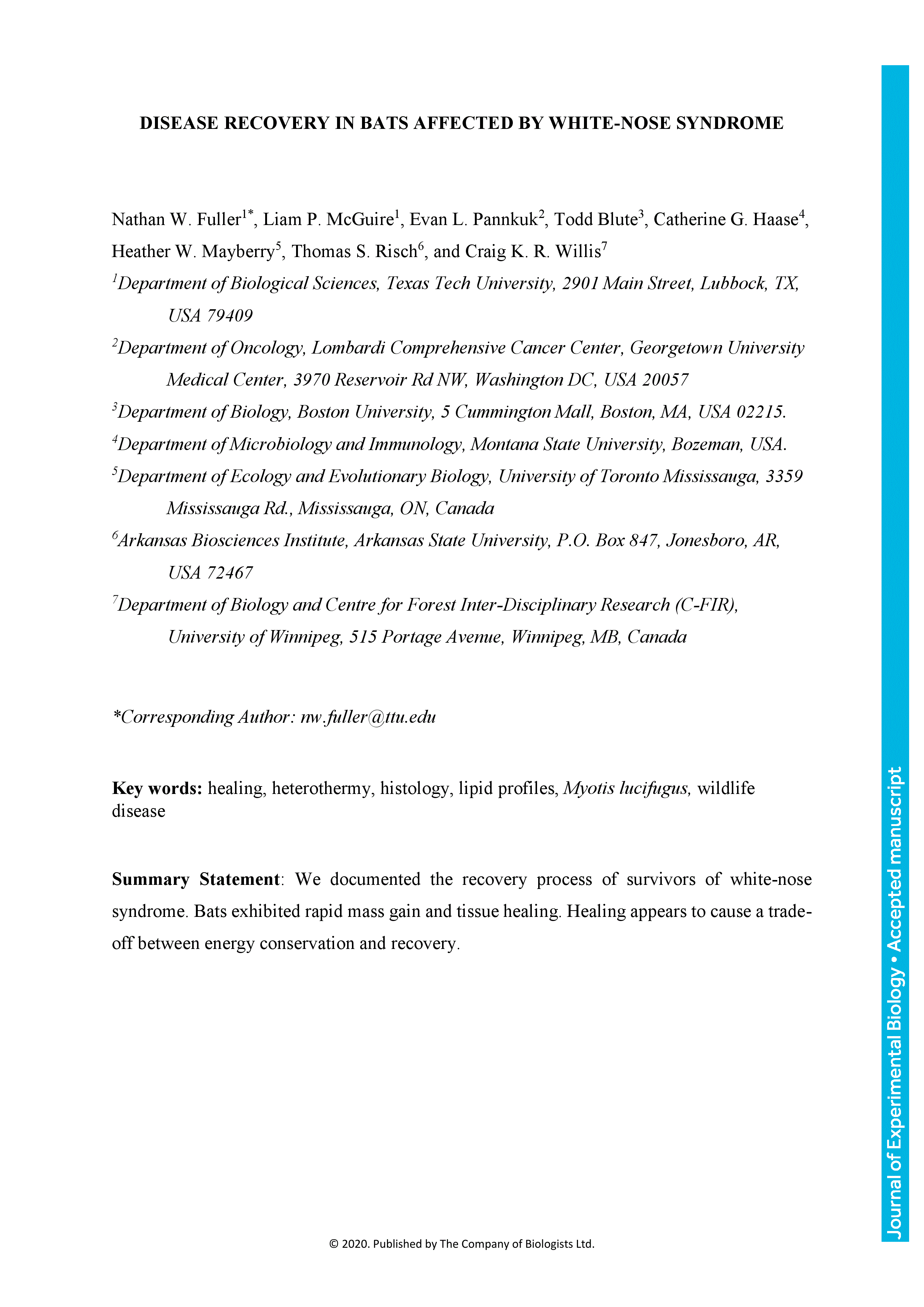Processes associated with recovery of survivors are understudied components of wildlife infectious diseases. White-nose syndrome (WNS) in bats provides an opportunity to study recovery of disease survivors, understand implications of recovery for individual energetics, and assess the role of survivors in pathogen transmission. We documented temporal patterns of recovery from WNS in little brown bats (Myotis lucifugus) following hibernation to test the hypotheses that: 1) recovery of wing structure from WNS matches a rapid timescale (i.e., about 30 days) suggested by data from free-ranging bats; 2) torpor expression plays a role in recovery; 3) wing physiological function returns to normal alongside structural recovery; and 4) pathogen loads decline quickly during recovery. We collected naturally infected bats at the end of hibernation, brought them into captivity, and quantified recovery over 40 days by monitoring body mass, wing damage, thermoregulation, histopathology of wing biopsies, skin surface lipids, and fungal load. Most metrics returned to normal within 30 days although wing damage was still detectable at the end of the study. Torpor expression declined overall throughout the study but bats expressed relatively shallow torpor bouts, with a plateau in minimum skin temperature, during intensive healing between about days 8 and 15. Pathogen loads were nearly undetectable after the first week of the study , but some bats were still detectably infected at day 40. Our results suggest that healing bats face severe energetic imbalance during early recovery from direct costs of healing and reduced foraging efficiency. Management of WNS should not rely solely on actions during winter but should also aim to support energy balance of recovering bats during spring and summer.
Disease recovery in bats affected by white-nose syndrome
Currently Viewing Accepted Manuscript - Newer Version Available
Nathan W. Fuller, Liam P. McGuire, Evan L. Pannkuk, Todd Blute, Catherine G. Haase, Heather W. Mayberry, Thomas S. Risch, Craig K. R. Willis; Disease recovery in bats affected by white-nose syndrome. J Exp Biol 2020; jeb.211912. doi: https://doi.org/10.1242/jeb.211912
Download citation file:
Advertisement
2023 JEB Outstanding Paper Prize shortlist and winner

The JEB Editors are delighted to announce the shortlisted authors for the 2023 JEB Outstanding Paper Prize. Read the winning paper - Tiny spies: mosquito antennae are sensitive sensors for eavesdropping on frog calls - by Hoover Pantoja-Sanchez and Brian Leavell from Ximena Bernal's lab at Purdue University, USA.
JEB Science Communication Workshop for ECRs

If you’re an early-career researcher interested in science communication and are attending the SEB Annual Conference in Prague this summer, come a day early and join the JEB Editors at a sci comm workshop to learn the key writing skills needed to promote your research to a broad audience beyond your peers (1 July at 14.30-17.30). Places are limited to 24 attendees, and applicants should apply through the SEB registration page by 30 April 2024.
Bridging the gap between controlled conditions and natural habitats in understanding behaviour

Novel technologies enable behavioural experiments with non-model species, in naturalistic habitats and with underexplored behaviours. In their Commentary, Scholz and colleagues discuss how to obtain a deeper understanding of the natural ecology and lifestyle of study animals.
Beluga metabolic measures could help save species

To help save animals from extinction, it’s important to understand what each species needs to survive. This led Jason John et al. to measure the metabolic rates of captive belugas to develop a ‘fish calculator’ showing that the whales need to eat ~23 salmon per day.
ECR Workshop on Positive Peer Review

Are you an ECR looking for tips on how to write concise, astute and useful manuscript reviews? If so, join the JEB Editors at a 2-hour JEB-sponsored Workshop on Positive Peer Review at the Canadian Society of Zoologists annual meeting in Moncton on 9 May 2024 at 13.00-15.00. There are 25 spaces for ECRs and selection is first come, first serve. To sign up, check the ECR Workshop box when you register for the CSZ meeting.



